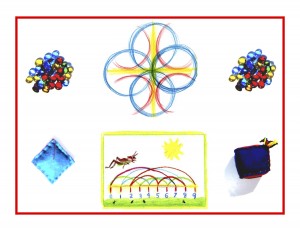Day 62
For one year, 365 days, this blog will address the Common Core Standards from the perspective of creating an alternate, ambient learning environment for math. Ambient is defined as “existing or present on all sides, an all-encompassing atmosphere.” And ambient music is defined as: “Quiet and relaxing with melodies that repeat many times.”
Why ambient? A math teaching style that’s whole and all encompassing, with themes that repeat many times through the years, is most likely to be effective and successful. Because the Common Core Grade 1 Math Standards address addition and subtraction exclusively, they will not appear here until the Grade 1 math blocks 3 and 4: the 4 processes. Math blocks 1 and 2 focus on meeting the numbers up close and personal through stories, movement, art, and hands-on activities like making real numbers.
If the numbers 1 to 12 are taught in the first math block, they can be spaced this way: a number story is told on Monday, after the form drawing main lesson. Three more number stories are told on Tuesday, Wednesday, and Thursday, and those stories are retold and illustrated the next day, so four numbers are covered each week. For a 20 day (or 4 week) block, the last week could focus on first the Roman and then the Arabic numerals.
The Waldorf curriculum follows child development as it parallels cultural development. The learning process then, begins with the beginning. Introducing the history and development of numbers through stories and pictures before using the numbers abstractly is therefore a sensible and wise approach. The Roman numerals are more concrete and direct than the Arabic, so that’s a good place to begin. It can be shown that they relate to counting on the fingers: l, ll, lll, and that the Roman numeral for 5 is derived from the “V” between the thumb and index finger, as the one for 10 is taken from the “X” formed by the two crossed thumbs.
It’s nice to do a hand tracing with the child(ren) to illustrate this and since a picture is always worth a thousand words, I will post the hand trace drawing in living color here tomorrow. Remember, knowledge ensues in an environment dedicated to imaginative, creative knowing, where student and teacher alike surrender to the ensuing of that knowledge as a worthy goal.












